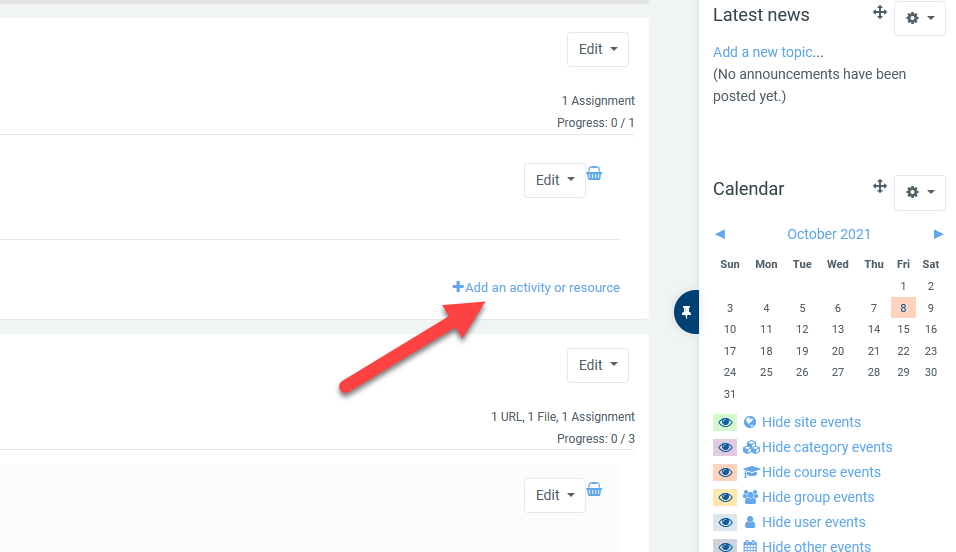Assignment settings (online or traditional)
This article guides you through creating an assignment activity, collecting submissions (file or text entry), annotating and grading the submissions without having to download or print them.
Adding an assignment
Turn the editing "on" in your course, click on "Add activity or resource" link, and select "Assignment" from the activity picker.
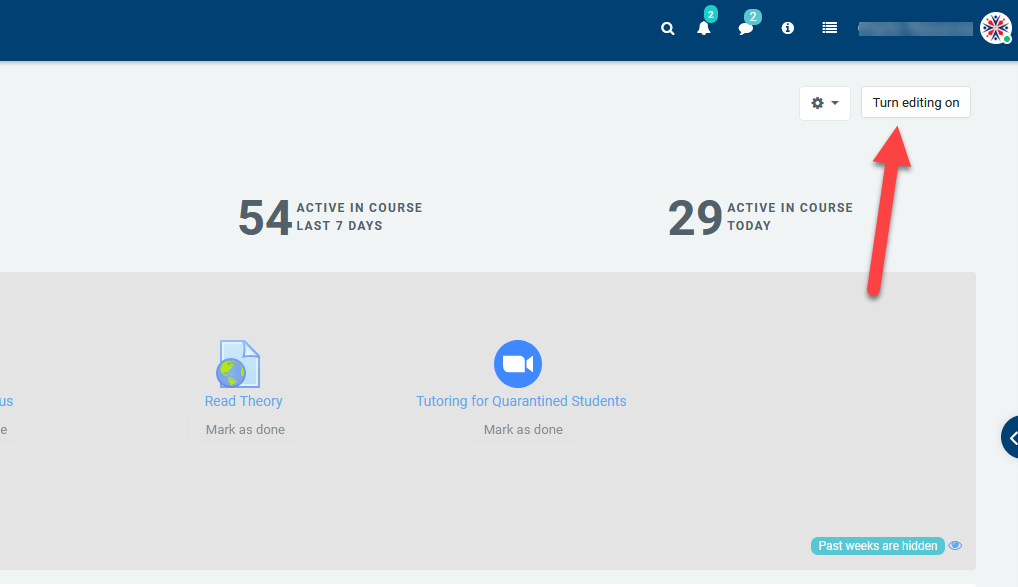 |
| 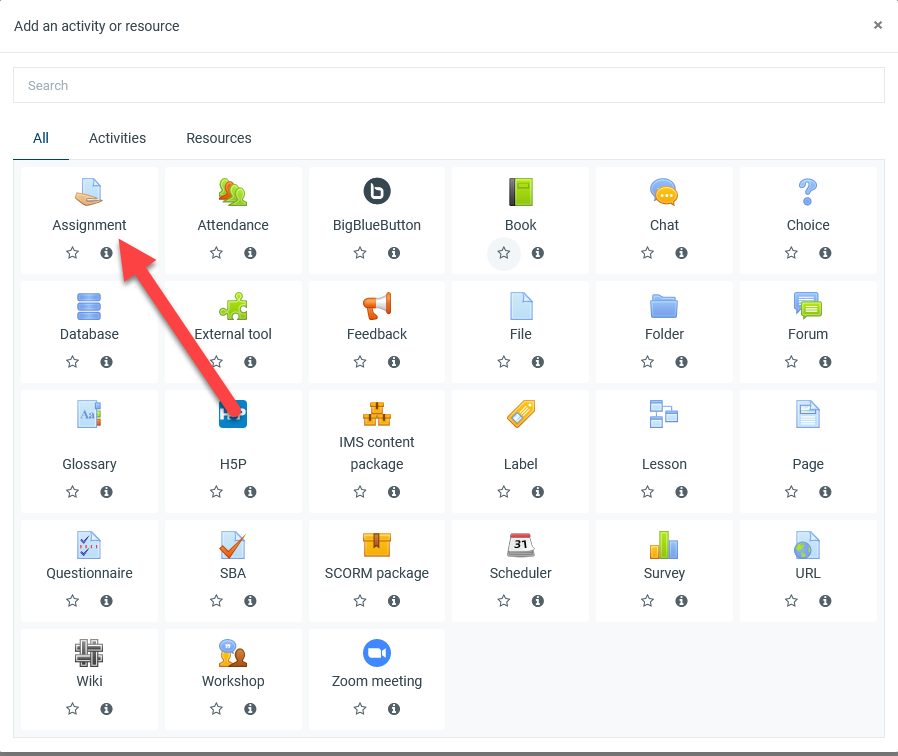 |
General settings
Fill in the title and description. You can attach a file to the assignment such as a rubric or guide for the work to be completed. You can also insert an image, video, or URL into the description of the assignment.
Additional files: Here you can add files that may be of help to the students as they do their assignments, such as, example submissions or answer templates.
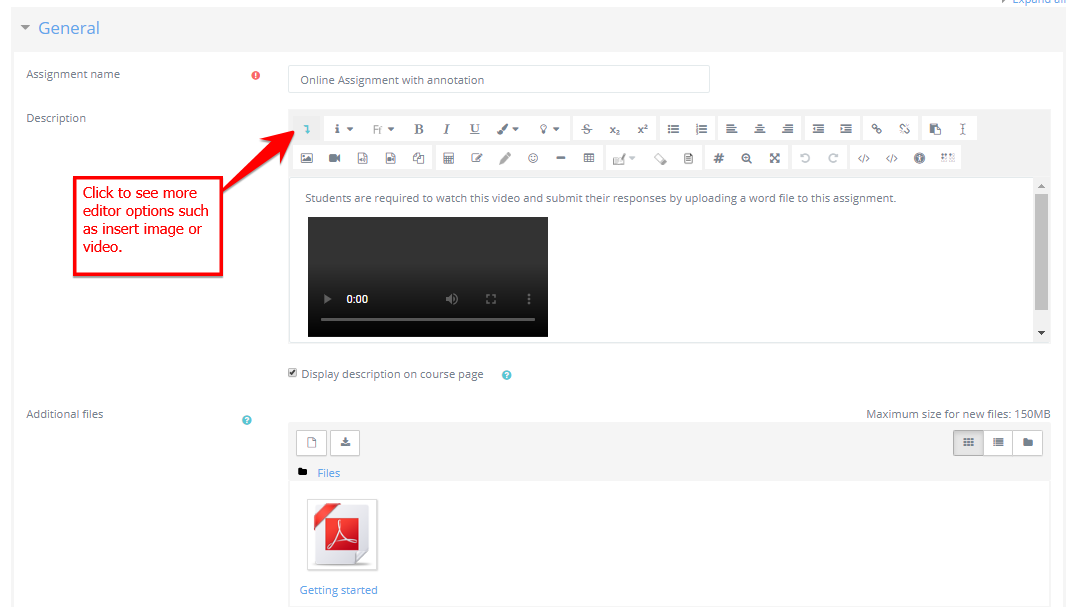
Availability
is important since it determines when your students can start submitting their work and how much time do they have. In addition to the due date, you can specify a cut-off date which would extend the time for students to submit their work. Extensions can be given to students individually if needed.
Allow submissions from: This stops students from submitting before the shown date but it doesn't hide the assignment and any included instructions or materials.
Due date: Submissions are still allowed after this date but will be marked as late.
Cut-off date: After this date, students will not be able to submit and the submit button will disappear.
Remind me to grade by: A date needs to be entered here in order for the assignment to display on the teacher's Calendar. It will display when at least one student has submitted.
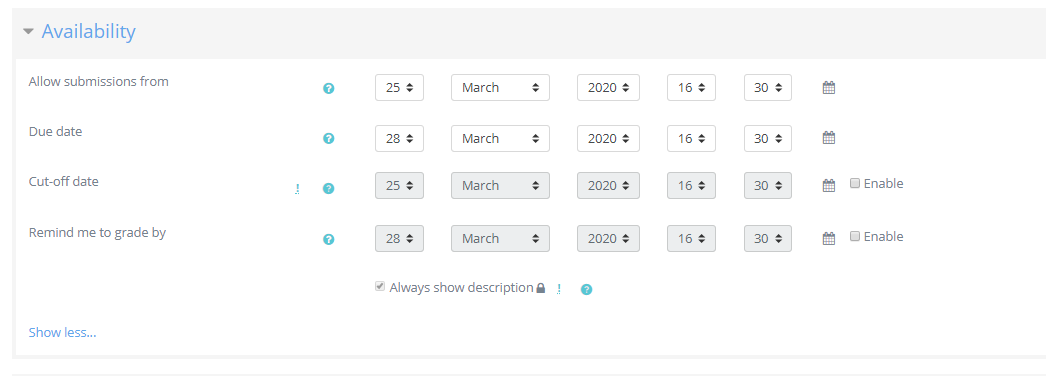
Submission type
(skip this step if you are creating offline assignment activity)
Next, you will determine what kind of submissions your students can do. A file submission or online text entry. This section is the place you determine if the assignment will require online submission or not. This can always be changed later on before the assignment is due.
Online text: Students type their responses directly in Radix using a text editor. Students may insert multimedia or paste URLs into this textbox. It's possible to set a word limit on an online text assignment. Students get a warning if they try to exceed the word limit. Numbers are counted as words and abbreviations such as I'm or they're are counted as single words.
File submissions: Students can upload one or more files of any type the teacher can open. The teacher can annotate uploaded PDFs, docx and odt files within the browser, and on saving, the annotated file is made available to the student.
Check with your admin to make sure the document converter is enabled. If not, you can only annotate the files submitted in pdf format.
Submission file types can be restricted, but it is better to leave the default setting which is accept all types.
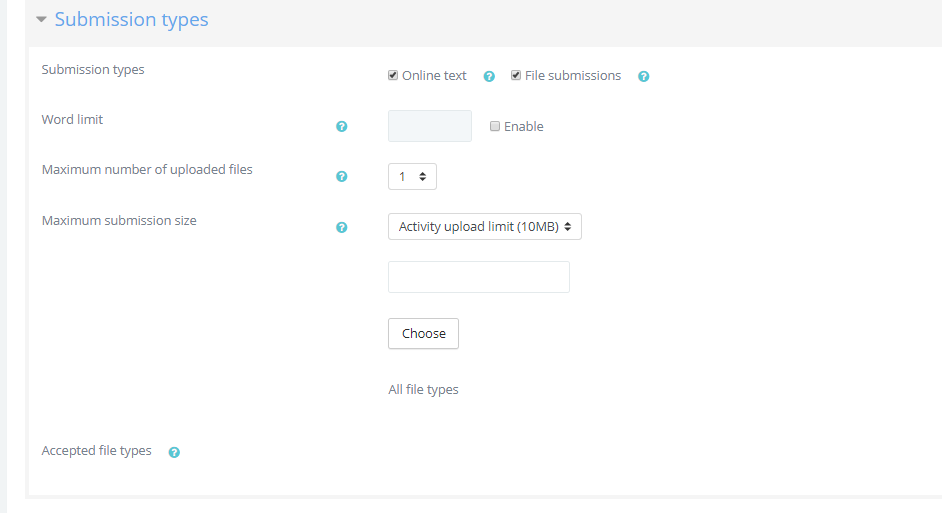
Feedback types:
If you are collecting "online text", comment inline feedback type would come handy when providing comments to text submissions.

Submission settings
Require students click submit button: If this is set to 'No' students can make changes to their submission at any time. (If you want to stop them changing work once you are ready to grade, click 'View/Grade all submissions'; locate the student and From the Edit column, click the action icon and select 'Prevent submission changes.'If set to 'Yes', students can upload draft versions of the assignment until such time as they are ready to submit. Clicking the submit button tells the teacher they have finished drafting and want the work to be graded. They can no longer edit it and must ask the teacher to revert to draft status if they need to change it again.To do that, click 'View/Grade all submissions; locate the student and from the Edit column, click the action icon and select 'Revert the submission to draft'.
Reverting to draft |
Prevent submission changes |
"With selected" to choose several students.. |
Require that students accept the Submission statement: An administrator can define a "Submission statement", ie, a statement where students promise the work is their own and which they must agree to before submitting their work. This may be done via Site administration>Plugins>Activity modules>Assignment. (A default statement is also available.) If the administrator has given teachers the option of using a submission statement or not, then it will be available in the assignment settings screen. If the administrator has forced the statement throughout the site, a teacher will not have this option in the settings but a student will see the statement when accessing their assignment.
Attempts reopened: If 'require students to click submit' is enabled, then students may only submit once. You can change this here to 'Manually' and reopen it for students to resubmit, or you can change it to 'Automatically until pass', for the students to keep resubmitting until they get a passing grade.
Maximum attempts: Here you can decide how many attempts to allow if students can resubmit. If a student has to keep trying until they get a passing grade, you might decide to limit the attempts even though they have not yet passed - or they might be trying forever!
Notifications
is a handy feature for teachers to be notified every time there is a new submission made. To get notified, turn on "Notify graders about submissions"
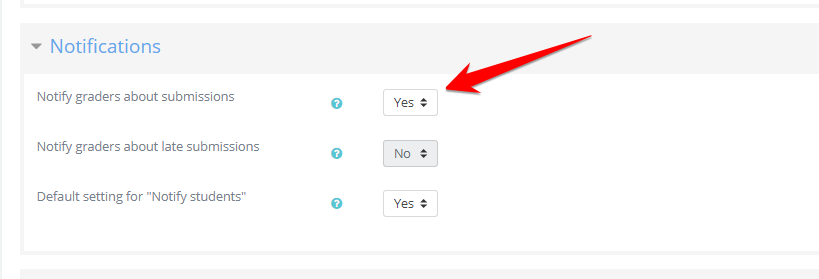
Grade
Remember to complete the grade settings by expanding the grade section. This is the most important section of the assignment settings. When grading an activity it is possible to use a grading scale, a grade point (numerical scale), or neither. Make sure to select the correct grade type for the assignment if it is not already pre-selected.
The maximum grade will determine the assignment's weight within the grading category, lower value means lower weight.
Some of the advanced grading methods such as Rubric can be used with assignment activities. if you are not using the advanced method, leave this setting as "simple direct grading".
Each assignment must be in a grading category. Each category has its own weight that will affect the students' term average differently. it is important to select the correct grading category while creating your assignment.
Setting a passing grade maybe connected with Activity completion and Restrict access such that a student will not be able to access a follow-up activity until they have passed this assignment. Passing grades does not determine students' official passing/failing states.
An assignment can be converted into an extra credit anytime by checking the box next to "extra credit". This option will only be visible after you select a grading category. The effect of extra credit assignments on term average depends on the number of assignments in the selected grading category and the max grade of the assignment.

Restrict access
Access can be restricted to this activity based on a specific group/period or passing grade of another activity on the course.
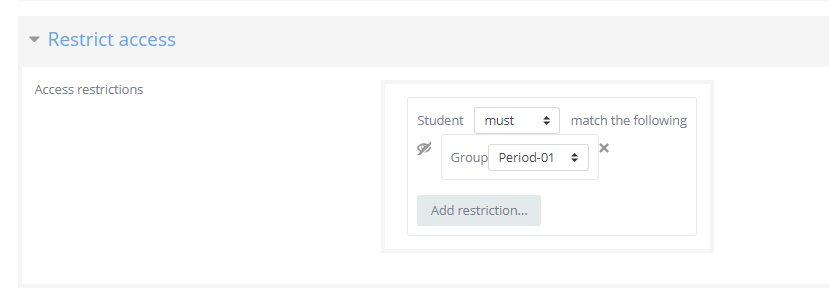
Summary
When done, click save and display to see the summary of the assignment you have created. On this page, you can see the number of participants, the number of students submitted and the number of submissions needs grading.
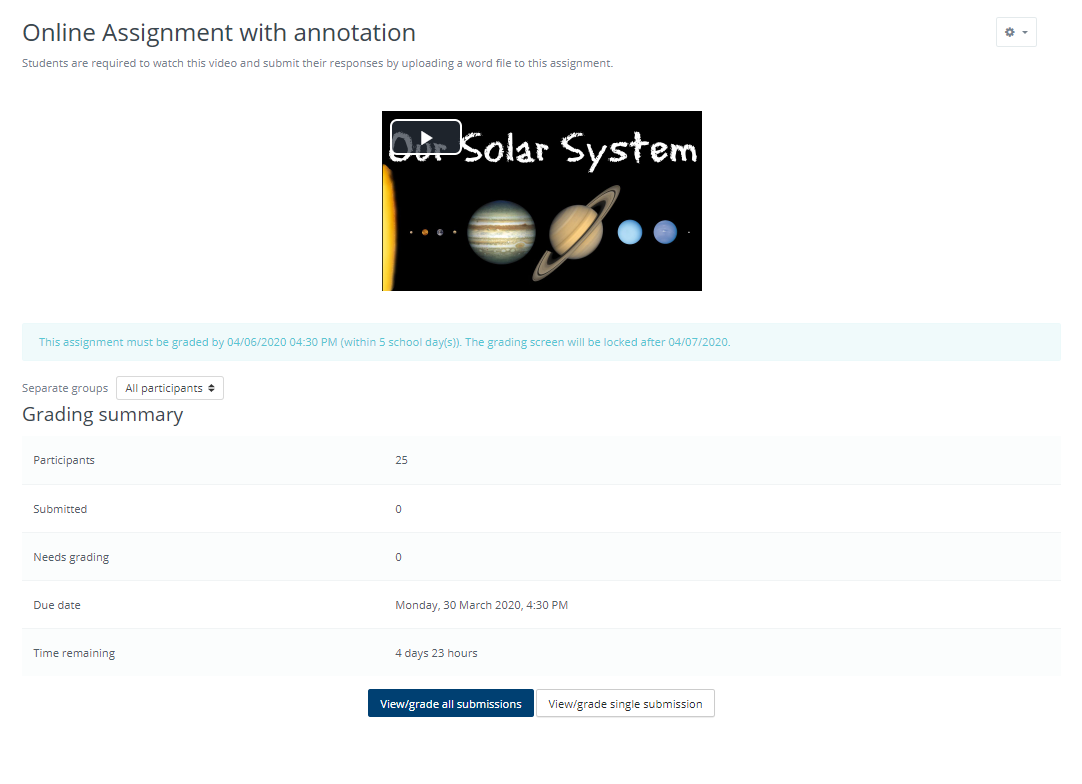
Which type of assignment submission suits you best?
You want students to type shorter or longer responses directly online
- Set Online text to Yes. This works well for younger children who will only manage a sentence or two and works just as well for higher education students who write more.
- Advantage - quick for the student to get started; no need to use a word-processing program and upload the file. The text is saved on a regular basis so it will be preserved if the student loses the page for some reason.
- Disadvantage: if the word count is expected to be large, setting Online text to No and File submission to Yes might be a better option.
You want students to submit work you can download in a specified program
- Set File submission to Yes, set the number of files you will allow using the Maximum number of uploaded files setting and the file sizes by using the Maximum submission size setting.
- Advantage - better than students emailing work as the whole class's work is collated in one space on your course. Markers can provide comments directly on the student's work.
- Advantage - with "Attempts reopened" enabled, teachers can see the progression through various drafts of a student's work.
- Disadvantage - assignments must be downloaded to be viewed (but they can be downloaded in bulk) and the teacher needs the appropriate program to open them.
You want students to submit files at different times for a project
- Set File submission to Yes, and use Maximum number of uploaded files to set the maximum number of separate files they can upload
- Advantage - all project files are in one assignment area for grading so they get a single grade.
- Disadvantage - all project files are in one assignment area for grading - so they can only have a single grade!
You want students to write a response to a video/sound file/image
- Set up an assignment allowing online text submission and get students to use the media icon to add video/sound/image files.
You want students to answer a series of questions on a video/sound file/image
- Investigate the SBA module. Assignments are really just for a single question.
You want to grade work students have done offline
- Uncheck the submission types when setting up the assignment. Students won't be required to do anything but you can use the assignment to grade them for work done outside of Radix LMS.
You want to view, comment on and send back students' assignments
- Set up an assignment allowing file submissions.
- Advantage: useful for teachers who like using the "comment" options in word-processing programs for example. If you have document converter enabled on your site and the students upload word processing files, they will be converted to pdf and you can annotate them inline. See the section Annotating PDF files.
- Disadvantage: if students upload other file types, you have to download them, comment and then re-upload them.
You want students to send you a comment or note along with their uploaded work
- If comments are enabled site-wide, students will be able to add submission comments; if comments are disabled site-wide, students will not be given the option to add submission comments.
You want to allow students to redraft and decide when to submit the work
- In the settings set Require students click submit button to Yes. Students can then control when their draft work is submitted to the teacher.
You want students to keep an ongoing journal or do an iterative assignment
- In the settings set Require students click submit button to No. Students can continue to make changes to their assignment and at no point do they 'submit'. If the work will be graded at some point it is recommended that either Prevent late submissions is set to Yes to ensure that no changes can be made after the due date, or all submissions are locked when grading commences ensuring that the work is not altered during grading.
- Advantage: the work remains in one place and is constantly improved, graded (if needed), and improved again.
- Disadvantage: there is no record/history of previous attempts (such as with the Wiki). The online text assignment does not replicate the display of a journal or blog where each new entry is added to the previous ones.
You want students to submit work in groups
- In the settings, set "Students submit in groups" to Yes. If you just do this, then once one student has submitted, the assignment will be flagged as submitted even if the others haven't contributed. If you want to ensure everyone has an input, set "Require students click submit button" to Yes and then change "Require all group members to submit" to Yes. The assignment will only be classed as submitted when each member has contributed, and once one student has submitted, the remaining members' names will be displayed for the group to see who still needs to add their input.
You want to grade students' work anonymously
- In the settings, choose "Blind marking". When students submit assignments, their names will be replaced by randomly generated participant numbers so you will not know who is who. Note that this is not totally blind marking because you can reveal their identities in the assignment settings and you can work out identities from the logs - so this might not be suitable if your establishment has very precise privacy requirements.
You want to read and grade student assignments offline
- In the settings, choose "Offline grading worksheet". When students have submitted, click "View/grade all submissions" and you can download their assignments from the link "Download all submissions" and download the grading sheet from the link "Download grading worksheet". You can then edit grades and re-upload the grading worksheet. You can also upload multiple feedback files in a zip from this drop-down menu.

